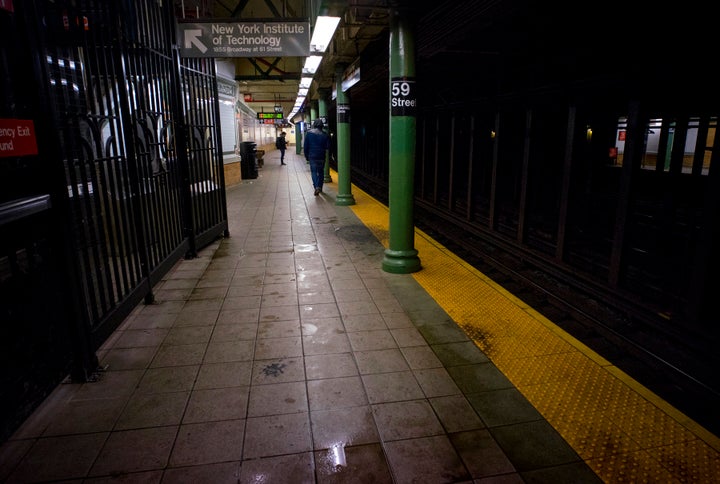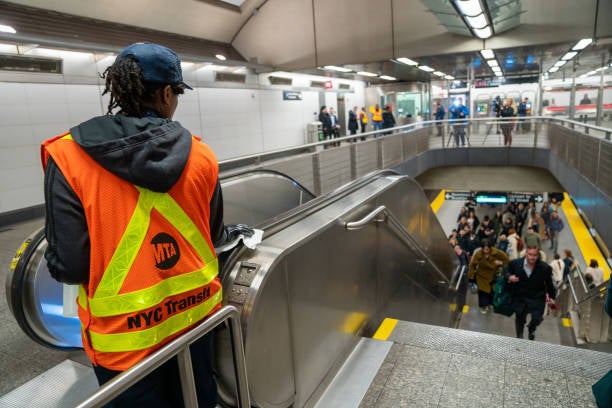Three disabled New Yorkers have filed a lawsuit against the Metropolitan Transportation Authority alleging it has failed to address dangerous gaps between subway trains and station platforms.
The MTA acknowledged “as early as 2012” that the gaps should never exceed 2 inches vertically or 4 inches horizontally at wheelchair-accessible platform locations, but gaps as large as 6 inches remain pervasive throughout the transit system, rendering it inaccessible or unsafe for people with physical or visual disabilities, the lawsuit says.
The suit was filed last week in state court by Jacquelyn Goldenberg, Emeline Lakrout and Athena Savides, who say they have been forced to abandon traveling on the subway because of unsafe gaps. Their petition seeks certification as a class action and demands the MTA be ordered to fix the gaps.
“This and other accessibility issues within the subway system, including lack of elevator access, have been repeatedly ignored while [the MTA and the city] prioritize other projects at the expense of access to the subway system for all,” the lawsuit states.
The MTA acknowledged the issue and said it’s working on it. “No agency has ever made a stronger commitment when it comes to focusing on making the transit system accessible for all riders,” an MTA spokesperson told HuffPost, referring to the MTA’s pledge to make most stations fully accessible by 2055.
As a native New Yorker, disability rights activist Emily Ladau knows this issue well. In December 2021, she said she took the subway to dinner and a show at Radio City Music Hall. The gap at her stop at 59th Street-Columbus Circle, she said, was bigger than any she had ever seen. She said she called out to MTA workers and others on the train for help, but no one did.
“I imagine they refused because if they were helping me and something had gone wrong, then they would have been responsible for me getting hurt. So I understand that,” Ladau told HuffPost. “But it’s really embarrassing to be put in the position where you are literally stuck somewhere, frantically trying to figure out a way out, and there is no way out.”
MTA workers, Ladau said, told her to ride the train to the next accessible station, turn around, and hope the gap on the other side of 59th Street-Columbus Circle was small enough for her to get off the train.
“The entire system is so utterly flawed and frustrating,” Ladau said. “I find it so ridiculous that my only option was to go completely out of my way to an entirely different neighborhood in the city because of the lack of accessible subway stops, and hope that I would be able to get off at the other end.”
People with disabilities make up 11% of New York City’s population, according to data from 2017. The gaps in the subway system not only impact wheelchair users, but also the 2.4% of New Yorkers with visual disabilities.

Sharon McLennon-Wier, executive director of the Center for Independence of the Disabled, New York, said that as a totally blind person, she has had a lot of unfortunate experiences with the subway system.
Several years ago, she said, her foot got caught in the gap between the platform and a Metro North train at Beacon Station. And in a prior incident, she said she fell into the subway tracks at the Wall Street station because the platform’s tactile domes — surfaces detectable by cane or foot that alert people with vision disabilities to drop-offs — were old and worn down.
“For many, many years, I was able to take the train by myself, and have no fear about traveling through the streets of New York City,” McLennon-Wier said. “But my fall in 2015, laying on that track, hearing the subway train coming towards me, the peril that I felt, I hope to never feel it again.”
Ladau said she spoke to an MTA board member about the gap she encountered at the 59th Street-Columbus Circle station, and was told that it would be fixed. But similar problems plague the subway system, she said.
Only 27% of New York’s 472 subway stations have elevators and ramps that make them fully accessible, and those elevators are frequently out of service. The MTA didn’t perform scheduled preventive maintenance on nearly 80% of subway elevators and escalators sampled in a 2017 audit by the city comptroller.
Other forms of transportation are available to disabled New Yorkers, including the paratransit service Access-a-Ride. Some Ubers and Lyfts also are wheelchair-accessible, but disabled people have reported issues with both ride-hailing options, which are significantly more expensive than public transportation.
The MTA announced in June, following two class-action lawsuits, that it would make 95% of its subway stations fully accessible by 2055.

The MTA’s initiative is scheduled to be completed more than six decades after the passage of the Americans With Disabilities Act. And, according to the lawsuit, the plan ignores fixing subway gaps.
“What we need to understand is that it’s a momentous settlement in the sense that every station in the whole system will have an accessible elevator,” McLennon-Wier said. “That’s amazing, and that will help many people, not just people with disabilities. But just think about elderly people, people that use suitcases, baby strollers. It will help a lot of folks. But there’s so much more to be done.”
The MTA also needs other improvements, such as announcements and audio cues, visual aids and tactile stripping in all subway stations, McLennon-Wier said.
New York lags behind other major American cities when it comes to the accessibility of its subway system. The Massachusetts Bay Transportation Authority — the country’s oldest subway system — has made strides in improving accessibility in the last decade, with the construction of more than 50 new station elevators and new accessible subway cars on multiple lines.
Ladau said she’s never experienced problems with gaps in the Washington Metropolitan Area Transit Authority, which is completely accessible.
“It’s very clear that you can create a transportation system without gaps,” Ladau said.

